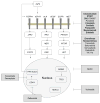Pediatric Rhabdomyosarcoma
- PMID: 26349418
- PMCID: PMC5486973
- DOI: 10.1615/critrevoncog.2015013800
Pediatric Rhabdomyosarcoma
Abstract
Rhabdomyosarcoma is the most common soft-tissue sarcoma of childhood, and despite clinical advances, subsets of these patients continue to suffer high levels of morbidity and mortality associated with their disease. Recent genetic and molecular characterization of these tumors using sophisticated genomics techniques, including next-generation sequencing experiments, has revealed multiple areas that can be exploited for new molecularly targeted therapies for this disease.
Figures




References
-
- Pappo AS, Shapiro DN, Crist WM, Maurer HM. Biology and therapy of pediatric rhabdomyosarcoma. J Clin Oncol. 1995;13:2123–39. - PubMed
-
- Pappo AS, Lyden E, Breitfeld P, Donaldson SS, Wiener E, Parham D, Crews KR, Houghton P, Meyer WH Children’s Oncology Group. Two consecutive phase II window trials of irinotecan alone or in combination with vincristine for the treatment of metastatic rhabdomyosarcoma: the Children’s Oncology Group. J Clin Oncol. 2007;25:362–9. - PubMed
Publication types
MeSH terms
Grants and funding
LinkOut - more resources
Full Text Sources

